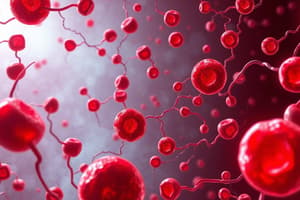Podcast
Questions and Answers
What is the primary function of red blood cells?
What is the primary function of red blood cells?
- To fight off infections
- To produce energy for the body
- To carry out photosynthesis
- To transport oxygen from the lungs to the body (correct)
Which protein found in red blood cells binds to oxygen and carbon dioxide?
Which protein found in red blood cells binds to oxygen and carbon dioxide?
- Mitochondria
- Hemoglobin (correct)
- Ribosomes
- Spectrin
What is the unique shape of red blood cells that provides a large surface area for gas exchange?
What is the unique shape of red blood cells that provides a large surface area for gas exchange?
- Biconcave disk (correct)
- Spherical
- Irregular
- Cuboidal
Why do red blood cells lack a nucleus or other organelles like mitochondria?
Why do red blood cells lack a nucleus or other organelles like mitochondria?
Where does hemoglobin bind to oxygen within the body?
Where does hemoglobin bind to oxygen within the body?
What is the role of spectrin in red blood cells?
What is the role of spectrin in red blood cells?
What is the lifespan of an adult human red blood cell?
What is the lifespan of an adult human red blood cell?
Where do immature red blood cells, known as reticulocytes, mature?
Where do immature red blood cells, known as reticulocytes, mature?
What medical condition results from a shortage of hemoglobin and oxygen-carrying capacity?
What medical condition results from a shortage of hemoglobin and oxygen-carrying capacity?
What can inefficient red blood cell production result from?
What can inefficient red blood cell production result from?
Which organ destroys adult red blood cells in the human body?
Which organ destroys adult red blood cells in the human body?
What can result from the body producing an excess of red blood cells?
What can result from the body producing an excess of red blood cells?
Flashcards are hidden until you start studying
Study Notes
Exploring Specialised Cells: Red Blood Cells
In the vast world of biological organisms, cells are the fundamental building blocks, each with their unique functions and adaptations. One such specialised cell type that plays a pivotal role in our bodies is the red blood cell (RBC), also known as erythrocyte. In this article, we'll delve into the characteristics, functions, and unique features of these remarkable cells.
Basic Structure and Composition
Red blood cells are biconcave disks, 6-8 micrometers in diameter, and are the smallest cells in the human body. Their distinct shape is due to their high concentration of hemoglobin, a protein that binds to oxygen and carbon dioxide. This shape provides a large surface area, enhancing the efficiency of gas exchange.
RBCs do not have a nucleus or other organelles such as mitochondria, ribosomes, or endoplasmic reticulum, as they are not required for their primary function of oxygen transport. Instead, they contain a protein called spectrin that helps maintain their structure and flexibility.
Function: Oxygen Transport and Carbon Dioxide Removal
The primary function of red blood cells is to transport oxygen from the lungs to the rest of the body, and to remove carbon dioxide from tissues to the lungs for elimination. Hemoglobin within RBCs binds to oxygen in the lungs, and this oxygen-loaded hemoglobin is transported to body tissues. At the tissues, hemoglobin releases oxygen to meet the cells' needs.
Regeneration and Lifespan
Red blood cells are continually produced in the bone marrow, primarily in the red bone marrow. Immature RBCs, called reticulocytes, are released into the bloodstream and mature within 1-2 days. Adult human RBCs live for about 120 days and are then destroyed by phagocytic cells in the spleen and liver.
Clinical Considerations
Several medical conditions can affect red blood cell production, function, or lifespan. For instance, anemia is a common condition where red blood cell production is reduced, leading to a shortage of hemoglobin and oxygen-carrying capacity. Inefficient RBC production can also result from malnutrition, certain medications, or genetic disorders such as sickle cell anemia.
Another condition affecting RBCs is polycythemia, where the body produces an excess of red blood cells. Polycythemia can result from genetic mutations, chronic hypoxia (low oxygen levels), or tumors that stimulate RBC production.
Conclusion
Red blood cells are specialised cells that play a critical role in our bodies, transporting oxygen and removing carbon dioxide. Their unique characteristics and functions allow them to perform this vital task efficiently. Understanding red blood cells and their adaptations can provide insights into diseases and disorders affecting these cells and their functions. Further research into red blood cells can help shed light on potential new therapies and treatments for anemia and other related conditions.
Studying That Suits You
Use AI to generate personalized quizzes and flashcards to suit your learning preferences.




